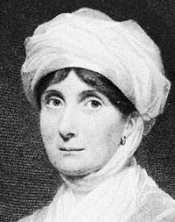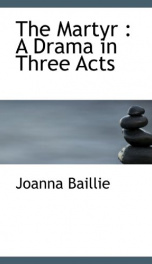Baillie Joanna

Joanna Baillie (September 11, 1762 – February 23, 1851) was a Scottish poet and dramatist. Baillie was very well-known during her lifetime and, though a woman, intended her plays not for the closet but for the stage. Admired both for her literary powers and her sweetness of disposition, her cottage at Hampstead was the centre of a brilliant literary society. Baillie died at the age of 88, her faculties remaining unimpaired to the last. Baillie was born in 1762. Her father, Rev. James Baillie (c.1722–1778), was a Presbyterian minister and briefly, during the two years before his death, a Professor of Divinity at the University of Glasgow. Her mother Dorothea Hunter (c.1721–1806) was a sister of the great physicians and anatomists, William and John Hunter. The Baillies were an old Scottish family, and claimed among their ancestors the Scottish patriot Sir William Wallace. Joanna Baillie was the youngest of three children; she had had a twin sister, but this child had died unnamed a few hours after her birth. Baillie grew up in close companionship with her sister, Agnes (1760–1861), and brother, Matthew Baillie (1761–1823), who became a celebrated London physician. Baillie’s early years were marked by a passion for the outdoors. Uninterested in books, she preferred playing in the garden, riding her pony, splashing on the banks of the River Clyde, and listening to ghost stories by the fireside. Baillie’s own gift for narrative invention revealed itself early in stories told to her companions or acted out in impromptu amateur dramatics. In 1769 the Baillies moved from Bothwell to Hamilton, South Lanarkshire, where Rev. Baillie had been appointed to the collegiate church. A few years later, at the age of ten, Joanna Baillie was sent to Glasgow to attend a boarding-school known for “transforming healthy little hoydens into perfect little ladies” (Carswell 266). Her intellectual and artistic faculties were here stimulated, and she displayed a talent for drawing, considerable musical ability, and a love of mathematics. Above all, however, was her facility in the writing and acting of plays. It was in Glasgow that she visited the theatre for the first time, kindling a passion which was to continue for the rest of her life. With the death of their father in 1778, the Baillie family found themselves with little to live on. Matthew Baillie went to Balliol College, Oxford, following in his uncles' footsteps in the study of medicine. Mrs. Baillie and her daughters retired to Long Calderwood, her family home near East Kilbride, where they led quiet lives as country gentlewomen. Dr. William Hunter of Windmill Street, London, died in 1783, leaving Matthew Baillie his house and private museum collection (which is now the University of Glasgow’s Hunterian Museum and Art Gallery). The following year Joanna, Agnes, and their mother moved to London to keep house for Matthew. There Joanna Baillie had access to literary society through her aunt Anne Hunter, the wife of Dr. John Hunter. Anne Hunter was a poet of some renown and the hostess of a salon, which included among its circle Fanny Burney, Elizabeth Carter, and Elizabeth Montagu. Encouraged by her aunt’s example, Baillie began to write poetry. While at Windmill Street, Baillie also began seriously writing drama. She had a ready supply of books and studied the French authors Corneille, Racine, Molière, and Voltaire, as well as Shakespeare and the older English dramatists. In 1791, Matthew Baillie married Sophia Denman, the daughter of a leading obstetrician, and relocated to the more fashionable Grosvenor Street. Mrs. Baillie and her daughters settled, after two or three moves, in Colchester. There, Joanna Baillie conceived the idea of her great work, the Plays on the Passions. By 1802 Joanna Baillie had moved from Colchester to Hampstead, then on the outskirts of London, where she and her sister passed the remainder of their lives. In 1806 Mrs. Baillie died. The two sisters, having inherited a small competence from their uncle Dr. William Hunter, chose not to marry. They were on intimate terms of friendship with many eminent figures in the arts and sciences, and were sociable, hospitable, and much admired and visited. Anna Laetitia Barbauld and Lucy Aikin were neighbours and close friends, and Sir Walter Scott was a regular correspondent with whom Joanna Baillie stayed in Scotland and who visited her whenever he was in London. In 1823, Baillie's much-loved brother Matthew died. His children and grandchildren continued to display the affection and pride in their aunt's achievements which had always marked the family. As she reached her seventies, Baillie experienced a yearlong period of unusual ill health which left her too weak to keep up her correspondence. However, she recovered and returned to her work. Joanna Baillie was anxious that all her works with the exception of her theological pamphlet (see Religious writing) be collected in a single volume, and had the satisfaction of seeing this ‘great monster book’ as she called it, which appeared in 1851, shortly before she died. Though no longer robust—‘Ladies of four score and upwards cannot expect to be robust, and need not be gay. We sit by the fireside with our books’ (Carhart, 62)—she had remained in good health until the end. She died in 1851 in Hampstead, having almost reached her ninetieth year. Her sister, Agnes, lived on to be 100. Both sisters were buried alongside their mother in Hampstead parish churchyard, and in 1899 a sixteen-foot-high memorial was erected in Joanna Baillie's memory in the churchyard of her birthplace at Bothwell. 1790 • Baillie’s first publication: Poems: Wherein it is Attempted to Describe Certain Views of Nature and of Rustic Manners. Baillie later revised a selection of these early poems which were reprinted in her Fugitive Verses (1840). • Her first poem, ‘Winter Day,’ was evocative of the winter sights and sounds in the neighbourhood of Long Calderwood. 1821 • Metrical Legends of Exalted Characters, which told in verse the heroic stories of such historical figures as William Wallace, Christopher Columbus, and Lady Grizel Baillie. These were inspired in part by the huge popularity of Walter Scott's heroic ballads, her enthusiasm for which had, she admitted, made writing drama ‘less interesting for a time’ (Baillie, ‘Memoirs’). 1836 • three volumes of Dramatic Poetry. 1840 • encouraged by her old friend the banker poet Samuel Rogers, Baillie issued a new collection, Fugitive Verses, some of which were old and some recently written. It was generally agreed that her popular songs, especially those in Scots dialect, would live on. 1849 • Baillie published the poem Ahalya Baee for private circulation [subsequently published as Allahabad (1904)]. 1790 • a tragedy, Arnold, which was never published. • ‘a serious comedy’ which was later burnt. • Rayner was written, though it was heavily revised before it was published in Miscellaneous Plays (1804). 1791 • Plays on the Passions first conceived. 1798 • the first volume of Plays on the Passions published anonymously under the title of A Series of Plays. Volume 1 consisted of Count Basil, a tragedy on love, The Tryal, a comedy on love, and De Monfort, a tragedy on hatred. In a long introductory discourse, the author defended and explained her ambitious design to illustrate each of the deepest and strongest passions of the human mind. The plays, the author explained, were part of a larger design and were a completely original concept. They arose from a particular view of human nature in which sympathetic curiosity and observation of the movement of feeling in others were paramount. Real passion, ‘genuine and true to nature’, was to be the subject; each play was to focus on the growth of one master passion. This unusually analytic approach generated much discussion and controversy, and in “a week or two Plays on the Passions was the main topic of discussion in the best literary circles” (Carswell 273). The authorship, though at first attributed to a variety of established male and female poets, was revealed in 1800 in the title-page of the third edition. 1800 • De Monfort was produced at Drury Lane with John Kemble and Sarah Siddons in the leading parts. Splendidly staged, the play ran for eight nights but was not a theatrical success. Henriquez and The Separation were coldly received. 1802 • second volume of Plays on the Passions published under Joanna Baillie's name, with a preface which acknowledged the reception given to volume one: ‘praise mixed with a considerable portion of censure’. Volume 2 consisted of The Election, a comedy on hatred, Ethwald, a tragedy in two parts on ambition, and The Second Marriage, a comedy on ambition. Baillie herself was of the opinion that these plays, especially Ethwald, exemplified her best writing. 1804 • published a volume entitled Miscellaneous Plays: the tragedies Rayner and Constantine Paleologus, and a comedy, The Country Inn. 1810 • the Scottish-themed Family Legend, produced at Edinburgh under the enthusiastic patronage of Sir Walter Scott, had a brief though brilliant success. It included a prologue by Scott and an epilogue by Henry Mackenzie. Its success encouraged the managers of the Edinburgh theatre to revive De Monfort, which was also well received. 1812 • third and final volume of Plays on the Passions published. It consisted of two gothic tragedies, Orra and The Siege, a comedy, The Alienated Manor, and a serious musical drama, The Beacon. The tragedies and comedy represented the passion of Fear, while the musical drama represented Hope. Introducing what she described as ‘probably the last volume of plays I shall ever publish’ she went on to explain that it was her intention to complete her project by writing further dramas on the passions of Remorse, Jealousy, and Revenge, but she did not intend to publish them since publication had discouraged stage production. 1815 • The Family Legend produced at Drury Lane, London. 1821 • De Monfort produced at Drury Lane, London, with Edmund Kean in the title role. • Constantine Paleologus, though written with John Kemble and Sarah Siddons in mind, was declined by Drury Lane. It was produced at the Surrey Theatre as a melodrama, Constantine and Valeria, and, in its original form, at Liverpool, Dublin, and Edinburgh.
do you like this author?
What readers are saying
What do you think? Write your own comment on this book!
write a commentWhat readers are saying
What do you think? Write your own comment on this author!
write a commentBook list

Poems,&c. (1790)
Wherein It Is Attempted To Describe Certain Views Of Nature And Of Rustic Manners; And Also,To Point Out,In Some Instances,The Different Influence Which The Same Circumstances Produce On Different Characters
Series:
Unknown
Year:
Unknown
Raiting:
3/5
Show more
add to favoritesadd In favorites

the weyhill ghost a tale founded on fact in four cantos with some smaller pi
Series:
Unknown
Year:
Unknown
Raiting:
4/5
Show more
add to favoritesadd In favorites

the two clerks of oxenford and where can it be tales
Series:
Unknown
Year:
Unknown
Raiting:
4/5
Show more
add to favoritesadd In favorites
Book list

Poems,&c. (1790)
Wherein It Is Attempted To Describe Certain Views Of Nature And Of Rustic Manners; And Also,To Point Out,In Some Instances,The Different Influence Which The Same Circumstances Produce On Different Characters
Series:
Unknown
Year:
Unknown
Raiting:
3/5
Show more
add to favoritesadd In favorites

the weyhill ghost a tale founded on fact in four cantos with some smaller pi
Series:
Unknown
Year:
Unknown
Raiting:
4/5
Show more
add to favoritesadd In favorites

the two clerks of oxenford and where can it be tales
Series:
Unknown
Year:
Unknown
Raiting:
4/5
Show more
add to favoritesadd In favorites

miscellaneous plays
Series:
Unknown
Year:
Unknown
Raiting:
2.5/5
Purchase of this book includes free trial access to www.million-books.com where you can read more than a million books for free. This is an OCR edition with typos. Excerpt from book: (hart.) No, no ! foftly, foftly ! I dare fay it is only fome fharping bufmefs they have got on hand, fuch. as needy Gentlemen are fometimes forced to follow: I have got my confcience newly cleared off at con- feffion laft week, and I am to make an offering next holy-day to the fhrine of our patron St. Bernard ; this is no time, goodiooth, to lofe fuch a fum upon fcruples. (Exit. END Of THE FIRiT ACT. ACT II. SCENE I. A, 'wood: dark night, with a pale gleam of dijiant lightning feen once or twice on the edge of the horizon. Advancing by the bottom oftheftage, a few moving lights, as if from lanthorns, a e feen, and at the fame timefeveral fignal calls and loud whiflles are heard, w th the diftant anfwcr returned to them from another part of the wood : Enter Count Zaterloo, Rayner, Shaflian, and others of the band, armed, and a few of them bearing in their hands dark lanthorns. It is particularly requejled if this play Jhould ever be atled, that no light may be permitted upon theftage but that which proceeds from the lanterns only. Count Zaterloo (to Sebaftian). They muft be near: didfl thou not hear their call? SIB AST I AN. Methought I did ; but who in this wild wood May credit give to either eye or ear ? How oft we've been deceiv'd with our own voices, From rocky precipice or hollow cave, 'Midft the confufed found of ruftling leaves, And creaking boughs, and cries of nightly birds, Returning feeming anfwer! COUNT ZATERLOO. Rayner, where ftandefl thou ? Da RAYNFR. Here, on thy left. COUNT ZATERLOO. Surely thefe wild fcenes have depriv'cl thy tongue Of fpeech. Let's hear thy voice's found, good man, To fay thou art alive Thou'rt marvellous filent: Didft thou not alfo hear them ? RAYNER. I know not truly if I did. Around me, All feems like ...
Show more
add to favoritesadd In favorites

a series of plays in which it is attempted to delineate the stronger passions o
Series:
Unknown
Year:
Unknown
Raiting:
4.5/5
Show more
add to favoritesadd In favorites

a series of plays
Series:
Unknown
Year:
Unknown
Raiting:
4.5/5
This scarce antiquarian book is included in our special Legacy Reprint Series. In the interest of creating a more extensive selection of rare historical book reprints, we have chosen to reproduce this title even though it may possibly have occasional imperfections such as missing and blurred pages, missing text, poor pictures, markings, dark backgrounds and other reproduction issues beyond our control. Because this work is culturally important, we have made it available as a part of our commitment to protecting, preserving and promoting the world's literature.
Show more
add to favoritesadd In favorites

a series of plays in which it is attempted to delineate the stronger passions
Series:
Unknown
Year:
Unknown
Raiting:
4/5
Each Passion Being The Subject Of A Tragedy And A Comedy.
Show more
add to favoritesadd In favorites

Poems, &c. (1790)
Series:
Unknown
Year:
Unknown
Raiting:
4/5
This book was converted from its physical edition to the digital format by a community of volunteers. You may find it for free on the web. Purchase of the Kindle edition includes wireless delivery. --This text refers to the Kindle Edition edition.
Show more
add to favoritesadd In favorites
What readers are saying
What do you think? Write your own comment on this author!
write a commentGenre
- Books / Children's Books / Literature
- Books / History / Ancient / Assyria, Babylonia & Sumer
- Biographies & Memoirs
- Nonfiction / Politics / General
- Literature & Fiction / Poetry
- Literature & Fiction / Poetry / General
- Literature & Fiction / Poetry / Anthologies
- Nonfiction / Education / Education Theory / History
- Reference / Atlases & Maps / World
if you like Baillie Joanna try:
readers also enjoyed
What readers are saying
What do you think? Write your own comment on this author!
write a commentGenre
- Books / Children's Books / Literature
- Books / History / Ancient / Assyria, Babylonia & Sumer
- Biographies & Memoirs
- Nonfiction / Politics / General
- Literature & Fiction / Poetry
- Literature & Fiction / Poetry / General
- Literature & Fiction / Poetry / Anthologies
- Nonfiction / Education / Education Theory / History
- Reference / Atlases & Maps / World
if you like Baillie Joanna try:
readers also enjoyed
Do you want to read a book that interests you? It’s EASY!
Create an account and send a request for reading to other users on the Webpage of the book!



